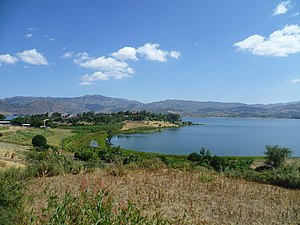Hayksee
| Hayksee | ||
|---|---|---|

|
||
| The Hayksee | ||
| Geographical location |
Amhara |
|
| Drain | none | |
| Location close to the shore | Haik | |
| Data | ||
| Coordinates | 11 ° 20 ′ 0 ″ N , 39 ° 42 ′ 0 ″ E | |
|
|
||
| Altitude above sea level | 1908 m | |
| surface | 23 km² | |
| length | 6.7 km | |
| width | 6 km | |
| Maximum depth | 88 m | |
The Hayksee or Hayqsee ( Ge'ez ሐይቅ Haik , amh. "Lake") is a freshwater lake in Ethiopia .
description
It is located north of Dese in the Debub Wollo Zone of the Amhara Region ( kilil ). The town of Haik is located southwest of the lake. The Hayksee is 6.7 km long and 6 km wide, with an area of 23 km². It has a maximum depth of 88 m and is at an altitude of 1908 m.
The German naming is a case of tautology , as the Amharic word Hayk means something like lake .
history
According to legend, the lake was created to avenge a pregnant woman who was treated unfairly by a princess. God was outraged by this injustice and in his anger all the land around the woman (except the ground on which she was sitting) turned into water and formed a lake that destroyed the princess along with her friends and family. Where the pregnant woman sat there was an island (today a peninsula), where the Istifanos Monastery (Stephanos Monastery) was founded by Iyasus Mo'a in the middle of the 13th century .
A former disciple of Iyasus Mo'a, Tekle Haymanot , founded the monastery of Debra Asbos (renamed Debre Libanos in the 15th century ) in Shewa . Tekle Haymanot was one of five bright young religious students who became the "five lights of Christianity" for southern Ethiopia. Iyasus Mo'a also played a role in the overthrow of the Zagwe dynasty by Yekuno Amlak and helped restore the Solomonic dynasty . When Yekuno Amlak rose to the throne, the Istifanos Church became the Istifanos Monastery.
The church was founded around the 8th century during the Aksumite Empire and was the first in Amhara Province. However, the events surrounding the establishment are not clear. Some legends tell that there was an Aksumite palace in Ambasselle across from the modern Istifanos monastery on the other side of the lake. Imam Ahmad Gragn looted and burned this church in November 1531. Legend has it that the kings and princes who lived in the palace founded the church. The ruins of the church are still visible today.
The first European known to see the lake was Francisco Álvares , who reached it on September 21, 1520. He reported that hippos and catfish lived in the lake and that lemons and oranges were grown around it.
Shortly before taking office in 1606, Sissinios I marched to the Hayksee area, where he drove out a group of Oromo who had invaded the vicinity of the Istifanos monastery.
Individual evidence
- ↑ a b c d R.M. Baxter and DL Golobitsh: A note on the limnology of Lake Hayk, Ethiopia . In: Limnology and Oceanography . 15, 1970, pp. 144-149.
- ^ Taddesse Tamrat: Church and State in Ethiopia. Clarendon Press, Oxford 1972, p. 110.
- ^ Taddesse Tamrat: Church and State , pp. 66-67.
- ↑ The dating is based on Taddesse Tamrat's interpretation of the date 720 in the Futuh al-Habasha ; see. Church and State , p. 36. Pankhurst's comment on the same passage suggests another reading, according to which the church was built in the year 720 of the Islamic calendar , i.e. 1344, in the first year of the reign of the ruler Newaya Krestos , who after the Futuh was the builder of the Church; see. Sihab al-Din Ahmad bin 'Abd al-Qader: Futuh al-Habasa: The conquest of Ethiopia. Translation into English by Paul Lester Stenhouse with annotations by Richard Pankhurst. Tsehai, Hollywood 2003, p. 265 and note 614.
- ↑ Local History in Ethiopia (PDF), website of the Nordic Africa Institute (last accessed on February 10, 2014)
